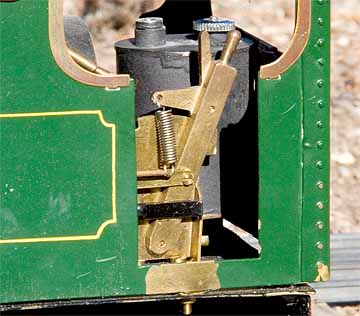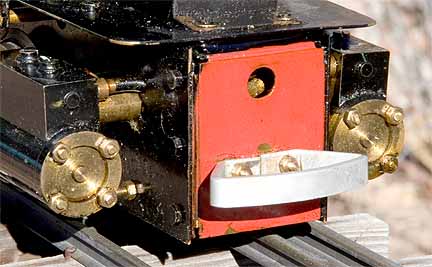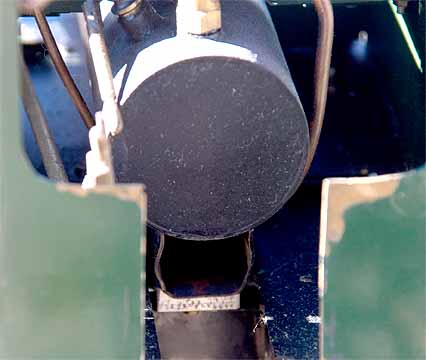
Back to Loco of the Month homepage
Back to Sidestreet Bannerworks
.
February 2009
Steamcraft's "Atlas"
by Marc Horovitz

Steamcraft, run by a man named David Taylor, was a company in Southport, England, in the early-to-mid 1980s. Steamcraft made a small variety of 16mm-scale locomotives in both 0 and 1 gauge. Interestingly, the company also offered brass, Japanese-import locomotives in HO scale that had their electrical guts removed and were then retrofitted with little steam power plants.
The engine under examination here, Atlas, was, I believe, Steamcraft's last offering. It is an 0-4-0T of vaguely Germanic proportions (there is no actual prototype) and was available in either kit or built-up form. I was told this particular example was built from a kit but, on close inspection, I'm inclined to believe it was purchased ready-made. It is equipped with LGB-compatible loop couplers, the engine evidently being expected to tap into the then-growing LGB market.
It has a gas-fired boiler of some interest. It is a single-flue boiler, but the flue is not inside the boiler proper. Instead, it is underneath, formed by a metal channel of rectangular section that is soldered to the boiler's bottom. This means that three sides of the channel, or flue, radiate their heat to the atmosphere, while only the topmost surface transfers heat to the boiler. There are a couple of longitudinal fins inside the flue, soldered to the bottom of the boiler, to help with heat transfer. Boiler fittings include a safety valve, a large whistle (hidden between the frames), a pressure gauge, and a throttle.
The burner is also of interest. It is basically a commercial propane-torch head attached to the butane fuel tank. The tank and the burner lift out of the engine for refueling. Once the tank is full, it clips in place on the cab's back sheet with the torch head resting in the nether end of the flue. This diabolical burner was evidently standard fare in Steamcraft locomotives.
Other innovations were incorporated into the engine. With the exceptions of the boiler, cylinders, and fuel tank, nearly the entire locomotive is made up of etched-brass sheet. This includes the footplate, frames, side and main rods, and all of the imitation-Walschaerts valve-gear parts. Unbushed brass is never a wise choice for rods and valve gear, and this thin-section material is even less so. Also, given the undercutting inherent in the etching process, this engine could be expected to wear out in record time.
When I acquired this locomotive, perhaps 20 years ago, I was told by Paul, the seller, that he had never gotten it to run. I took him at his word and never tried it. In preparation for this article, though, I took the engine out and gave it a good once over. It was quite stiff from congealed oil on most of the parts. After a good cleaning and loosening up, I tried it on air. It did actually run, but perhaps not as briskly as one might hope. Would it run on steam? Would the burner even make steam? Let's find out.
The run
Well, Paul was wrong -- the engine did run. . .sort of. I prepared it in the usual way, filling the lubricator, fuel tank, and boiler with their respective fluids. The run day was cool, with temperatures in the low 50s. I put the burner in place and lit it at the front end of the flue. The fire flashed back nicely to the torch head. I adjusted the flame to what, in my ignorance, seemed reasonable. It was LOUD!
After five minutes, there was nothing showing on the gauge. I attributed this to the cool weather. After 10 minutes, the situation was the same. There was a little steam in the boiler, but not enough to make any difference. With no other options, I cranked the fire up as high as it would go. The thing roared like a jet engine.
After a couple more minutes, the needle on the gauge began to show signs of life. In a little while it was up to 20 pounds. . .then 30. . .then 40. I gave the whistle a toot. The large whistle on this engine is loud and clear. Its proximity to the flue ensured that there would be no condensate in it. Then I opened the throttle. After a few seconds of the usual gurgling and spluttering, the engine moved off. Even with the throttle wide open, though, it wouldn't travel at any more than a sedate speed.
After a couple of laps around the track the pressure had dropped to 20 psi, so I closed it down to let it catch its breath. With pressure up again, off it headed. And so it went for the duration of the run. Even with the fire howling, the engine ran out of water first. I shut it down and called it good.
Since this locomotive had virtually never run before, its valve gear hadn't had a chance to wear out and it performed pretty well. However, with continual use, I doubt that it would last long. Despite its lackluster performance, it is a historical piece that incorporates some interesting ideas. It's possible that some mechanical tweaking might improve general performance, or maybe all it would take is running on a warmer day. Perhaps I'll give it another try next July.
|
|
|
| Builder | Steamcraft (David Taylor), UK |
| Date built | Mid 1980s |
| Gauge | 45 mm |
| Scale | 1:22.5 |
| Boiler | Single external flue |
| Fittings | Safety valve, pressure gauge, throttle, whistle |
| Fuel | Butane |
| Blow-off pressure | 45 psi |
| Cylinders | Two, double-acting piston-valve |
| Reversing gear | Imitation Walschaerts |
| Lubricator | Displacement |
| Weight | 4 lb., 12 oz. |
| Dimensions | Length, 10-1/4"; width, 4-3/8"; height, 6-3/4" |






Right: A dummy lamp sits on a lamp iron atop the smokebox. Smokebox-door details are etched brass.


Right: The burner in place in the cab.



Back to Loco of the Month home page
Back to Sidestreet Bannerworks home page
This page and its contents
Copyright Sidestreet Bannerworks, 2009
.